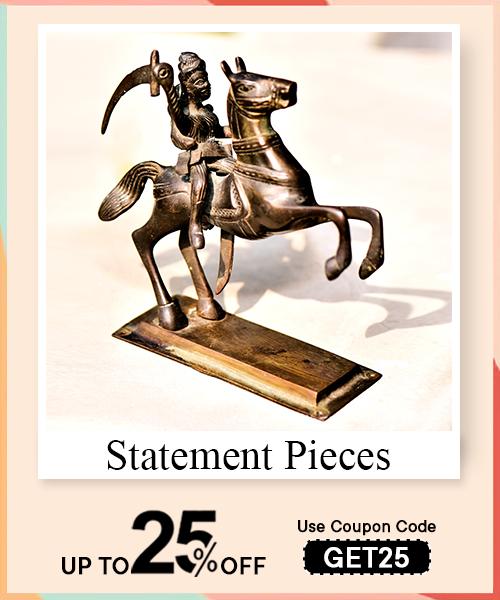Indian art shows the country's rich history, range of cultures, and religious depths. From prehistoric cave paintings, Indian art has evolved through millennia. Today, it showcases a diverse array of masterpieces spanning centuries.
Cave paintings from as early as 30,000 BCE provide proof of the art's roots. The Indus Valley Civilization was the first known civilization in the Indian subcontinent. It has left behind elaborate stamps and sculptures of human and animal forms.
- Classical Indian art focuses on symmetry, proportion, and precision. Like magnificent sculptures from the Gupta period and detailed paintings of the Mughal Empire.
- Madhubani, Warli, and Pattachitra are folk art forms that reflect the colorful cultural traditions of diverse areas. The use of bold colors and distinctive designs tells stories and celebrates festivals.
- With globalization and industrialization, Indian artists have embraced various mediums and techniques. This has led to the emergence of a vibrant contemporary art scene.
Religion and culture have had an impact on Indian art throughout history. Hinduism, Buddhism, Jainism, and Islam all changed Indian creative expression. Temples, stupas, mosques, and palaces are backdrops for architectural artworks.
Indian art has evolved to reflect various influences. It includes shifting political, social, and cultural forces. Each era in India's history has contributed to its rich cultural tapestry. Artists showcased intricate craftsmanship and artistic expression during the Maurya and Gupta eras. The Mughal Empire introduced delicate miniature paintings. These paintings became renowned for their intricate detail and refined beauty. These diverse artistic styles have shaped India's cultural identity. They continue to inspire artists worldwide.
Read More:RADHA KRISHNA PAINTINGS: CAPTURING THE ETERNAL LOVE BETWEEN TWO LOVERS
India is a country noted for its lively culture and rich past. It has diverse traditional art forms that have evolved over the ages. Let us look at the many dimensions undertaken to preserve and revive it.
India's folk art traditions reflect the country's vast cultural terrain. Folk art in India encompasses Bihar's Madhubani paintings and Maharashtra's Warli art. These traditions entrench themselves in local customs, rituals, and beliefs. Folk artists across India use natural materials and vibrant colors. Their artworks depict scenes from everyday life, mythology, and the natural world.
Classical Indian art styles include Bharatanatyam, Kathak, Odissi, and Kuchipudi. These stylized dance traditions feature precise footwork, expressive gestures, and extravagant costumes. Classical music, like Hindustani and Carnatic forms, features elaborate melodies and rhythmic patterns. This has been passed down through generations.
Hinduism, Buddhism, Jainism, Islam, and Sikhism influence religious and spiritual art in India. Hindu art includes representations of gods and goddesses. It also features beautiful temples and vibrant religious celebrations—Buddhist and Jain art, famed for its tranquil sculptures and cave paintings. Islamic art and architecture in India have elaborate geometric designs and calligraphy. Sikh art traditions, like the vivid art of Gurbani, use paintings, music, and poetry. These traditions commemorate the teachings of Sikh gurus.
Tribal art in India includes local customs and ceremonies. Each tribe has its unique creative style. Gond tribes of Central India and the Warli tribes of Maharashtra are common tribal art forms. These forms contain themes influenced by nature, animals, and tribal mythology. These art forms are passed down from generation to generation. Tribal tribes use these forms to express themselves and identify themselves.
Bringing back and maintaining native Indian art forms has recently gained popularity. Government efforts, cultural groups, and grassroots movements support artists. They provide training, resources, and platforms. Collaborations with modern artists and international exhibits expand the audience. Internet platforms also contribute to presenting creative forms. These efforts assure the survival of traditional art for future generations.
Religion inspires themes, symbolism, and Indian art styles. Hinduism's deities and epic stories influence complex temple building, sculpture, and art. Buddhist and Jain art emphasize nonviolence, compassion, and enlightenment. They do it through tranquil sculptures and cave paintings. Islamic art in India symbolizes Islam's spiritual principles with geometric designs and calligraphy. Sikh art traditions honor the teachings of Sikh gurus. They do so through bright paintings and devotional music. These traditions foster a sense of togetherness and devotion among followers.

India's substantial geographical size and diverse cultural environment provide many folk art styles. Madhya Pradesh's Gond art enjoys elaborate designs reflecting tribal life and nature. West Bengal's Patua painters express uniqueness in their art. Gujarat's Kutch area is famous for its exquisite mirror work. Every part of India showcases diverse customs and beliefs through its art forms.
Indian folk art is rich in symbolism. Each pattern holds several levels of meaning and importance. The peacock, for example, signifies elegance and beauty in Madhubani painting. Elephants represent wisdom and power in Their performances. In Tibetan Buddhist Thangka paintings, patterns like infinite knots reflect eternal harmony. In many Indian folk traditions, the mandala depicts the world and spiritual unification. These symbols embellish artworks. They communicate and express tales, beliefs, and cultural values through visual images.
The importance of folk art in modern Indian art is vast. Artists like MF Husain and Jamini Roy get ideas from folk art, and folk patterns combined with a modern style produce ground-breaking works. The Bengal School and the Progressive Artists' Group were contemporary art movements. They used folk traditions to break from colonial influences and reconnect with India's cultural heritage. Artists today still investigate and reinterpret folk themes, bridging the divide between tradition and innovation in Indian art.
It is essential to preserve and revitalize India's traditional folk art. The government, NGOs, and grassroots organizations are all helping and teaching folk artists. This helps them preserve their art and find new buyers. Artisan cooperatives and internet platforms help folk artists.
Indian art today is bigger and more important. MF Husain, Bharti Kher, and Subodh Gupta were essential artists. They played a significant role in making Indian art well-known around the world. The themes in this art cover a wide range of topics, like social issues and exploring identity. The Progressive Artists' Group and the Baroda School influenced this art. Modern artists use new methods and materials to express themselves. They also challenge traditional norms. They use mixed media, digital art, and installation. Globalization changed contemporary Indian art. It allowed for cultural exchanges and new perspectives. Local and global influences mix. They create a diverse and vibrant contemporary art scene. It continues to evolve and inspire in India and beyond.
Read More:THE HISTORY OF TANJORE ART: A RICH AND VARIED LEGACY
Indian tribal art shows the diverse cultural heritage of India's native communities. Each tribe has its artistic traditions. These traditions range from paintings to crafts. Diverse regions spread the tribes. Artists use both traditional and contemporary approaches. They incorporate new materials and conserve time-honored processes passed down through generations. Tribal societies use art to show who they are and what they believe and do. They create artwork that represents their culture. Efforts are happening to preserve and revitalize these art forms. We aim to prevent forgetting them. Campaigns are being organized to raise awareness and support tribal artisans. Tribal art is essential in Indian society. It bridges the gap between the past and the present. We promote respect for native cultures. We also encourage respect for their contributions to the country's artistic legacy.
Indian art and culture connect and strongly influence each other. Indian culture has influenced art in many different forms. It uses vibrant colors, intricate patterns, and spiritual themes. Indian art includes cultural symbols and motifs, including the lotus flower, peacock, and gods and goddesses. These symbols represent essential philosophical and theological ideas. Indian art and literature have a connection. Poetry and epics often inspire artistic creations.
Folklore and mythology have influenced Indian art. Ancient scriptures inspire paintings, sculptures, and performances. They showcase stories and characters. Cross-cultural influences have improved Indian art and culture. Contacts with adjacent nations and colonial relations have had a long-lasting impact. Famous Indian painters have contributed a lot to the art world.
Every painter has left a unique legacy. Raja Ravi Varma is famous for his realistic portraits and mythical paintings, which transformed Indian art. Tagore's artistic works represented his many abilities and intellectual perspectives. Amrita Sher-Gil's intense and contemplative works laid the groundwork for modern Indian art. M.F. Hussain's daring paintings provoked outrage while also making great worldwide accomplishments. Anish Kapoor's monumental sculptures have made him famous worldwide. They show the talent and creativity of Indian artists around the world.
Indian folk art painting has a long history. The art style has been growing for centuries with the cultures and traditions of the country. Famous painters Jamini Roy and Nandalal Bose have made significant contributions to it. They reflect the spirit of rural life and cultural legacy through their work. Madhubani, Warli, and Pattachitra techniques use vegetable dyes and handmade paper. These materials are natural.
These techniques express a connection to the environment and cultural rituals. Indian folk art painting often explores themes of nature, mythology, and daily life. Artists today are changing traditional folk art painting to suit modern preferences. These themes carry deep symbolic meanings rooted in tradition. They mix old techniques with contemporary themes. The blend of old and modern brings new vitality to Indian folk art painting. It assures its relevance and continuous appreciation in today's changing world.
Indian wall art encompasses a rich tapestry of traditional and modern styles. It reflects the nation's diverse cultural heritage. Indian wall art adorns ancient monuments and modern buildings, ranging from intricate frescoes to contemporary murals. In Indian architecture and decor, wall art plays a vital role. It serves to narrate stories, depict deities, and evoke emotions. Artists use various techniques, including mural painting, relief work, and intricate carvings, using materials such as natural pigments, stone, and clay. Each motif and design carries profound symbolism. India's religious, mythological, and cultural beliefs root this symbolism. These designs showcase the country's spiritual depth and artistic finesse. Efforts are underway to preserve and conserve ancient Indian wall art. Despite the challenges of time and environmental degradation, people use advanced techniques and traditional methods. This safeguards these invaluable cultural treasures for future generations to admire and cherish.
Indian scale art has complex patterns and brilliant hues. It has distinct traits that set it apart from other art genres. Rangoli, kolam, and alpona are the most common types. People make them using powdered colors or rice flour. Indian scale art emerged from ancient ceremonies and customs. Thousands of years of history provide evidence for this. It has long been an essential component of Indian culture. People use it to represent wealth. They also use it to ward off evil spirits at festivals, weddings, and other special events in the current day. Indian scale art has found new uses and developments. Artists experiment with new materials and methods to fit modern lives but also strive to keep their traditional core. Its adaptability and aesthetic appeal continue to make it a popular art form in India. It bridges the gap between tradition and contemporary.
Globalization has influenced Indian art and culture, bringing both opportunities and challenges to the forefront. Indian artists have incorporated new techniques and themes into their work due to increased exposure to global trends and influences. This has led to a fusion of traditional and contemporary styles. Yet, this integration has also raised concerns about cultural appropriation. Foreign artists sometimes adopt elements of Indian culture without proper understanding or respect. Globalization has expanded the global recognition and market for Indian art. But, some issues remain. Works by Indian artists are gaining prominence on the international stage. Diaspora artists have made significant contributions to Indian art. They blend their cultural heritage with their experiences abroad. Yet, Indian artists face challenges in navigating the competitive global art market. They need more access to resources. They must balance commercial success with artistic integrity. Still, globalization presents opportunities for Indian artists. They can showcase their talents and perspectives to a broader audience. This fosters cultural exchange and innovation.
Read More:THE SECRETS OF THANGKA PAINTING: REVEALED
Indian art reflects a rich cultural heritage. It evolved from cave paintings to intricate sculptures. Vibrant colors, intricate designs, and profound symbolism define Indian art. It captivates audiences worldwide. Indian artists blend ancient techniques with modern influences. From traditional folk art to contemporary interpretations, Indian art inspires and reflects cultural pride. Celebrating its achievements and embracing its future, Indian art enriches lives globally.
















